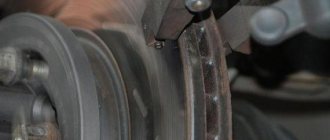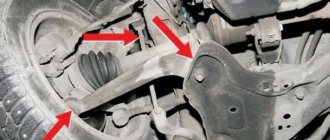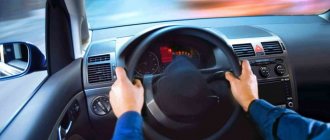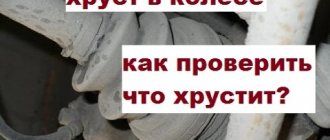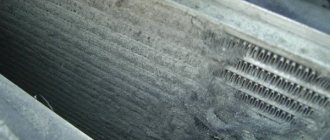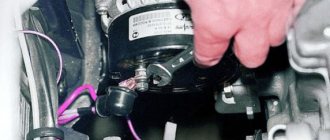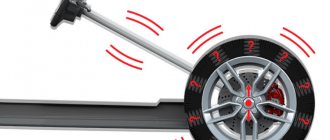A knocking sound when turning the steering wheel indicates problems with the vehicle's steering system. The causes of knocking may be malfunctions of the constant velocity joint (CV joint), ball joint, wear of the steering tip and/or support bearing, stabilizer link and other malfunctions. In any case, when a knock is heard when turning the steering wheel, it is necessary to carry out diagnostics as quickly as possible, since malfunctions of the steering system not only worsen over time, but can also lead to emergency situations when the car is moving, even an accident.
If you hear a noticeable knocking noise when you move the steering wheel left to right: diagnosis
Probable Causes
If an audible knocking sound in the front suspension when turning the steering wheel indicates wear in its constituent parts, then an extraneous clicking sound when the steering wheel rocks requires inspection of other structural elements. As a rule, the problem lies in the vehicle control system.
Statistics show that there is something to knock in the “steering wheel”. Any pairing may come under suspicion:
- Gap in the fit between the steering tip and the strut.
- Excessive play in the steering rack.
- There is a problem with the steering shaft driveshaft.
- Free movement of the steering wheel on the shaft.
- Gap in steering rod joints.
These parts are present in the design of any car. Knowing the location of all the landings, it remains to identify the defective pair.
For your information. Some old foreign cars have a folding steering column assembly, which breaks under the influence of a critical load that occurs during an accident. He can knock too.
How to identify knocking: expert methods
The classic approach to identifying a faulty unit will be explained in any garage. Its essence is trivial: just ask the assistant to shake the steering wheel and at this time put his hand on the mentioned connections.
Steering rack
However, in some situations this technology loses its relevance. In particular, it will not be possible to identify a defect in the mechanism using this method. To identify a problem in the gear-rack engagement, it is necessary to carry out the following experiment:
- If there is power steering (hydraulic booster): a knocking sound appears when the steering wheel is rotated on a car with the engine turned off, but when the engine is running, there is no knocking at the place.
- There is no power steering: drive along a road section with a changeable direction - when you swing the steering wheel left to right, a knock is heard, but when turning, the rack does not knock due to the small wear of the working surfaces of the gearing in the extreme positions.
For your information. It is not recommended to tighten a worn rack. One of the owners of Hyundai Solaris performed this procedure and after 10,000-12,000 km the steering wheel began to bite. An autopsy showed that the mechanism was beyond repair.
Emergency system
It is also possible to determine experimentally whether the steering column folding assembly is the cause of the knocking. It is enough to swing the “steering wheel” to the sides, while simultaneously pressing it to the bottom. The sound disappeared - the problem is in the emergency system.
Lyrical digression
In Lada Kalina, the steering rack never makes a knock when we are talking about a new car. This is also true for the break-in period. Let's say in your case this is not done. Then, do not try to repair anything, but go straight to the dealer. According to reviews, the defect in question is covered under warranty, and most car dealers do this: the steering rack assembly is replaced with a new one.
This is what the replacement unit looks like, the rack assembly
There is a logic here. At the factory, adjustments are made correctly (this is true in 99.9% of cases). If a defect appears, the dealer replaces the assembly without expecting that adjustment will solve the problem. The owner does not need to hope for this either. The choice is yours.
What causes a knocking sound in the front suspension of a car when turning the steering wheel while driving?
The chassis and steering mechanism are tightly coupled and perform a single function. One rack command is not enough to turn the wheels in one direction. The racks, which are connected by tips and rods to the rack and pinion assembly, must not only absorb shock, but also rotate around their own axis. This became possible with the introduction of movable mounts.
What's causing the knocking?
When there is a knocking sound when turning the steering wheel while driving, but no extraneous sounds are observed in place, we can firmly state that there are problems with the suspension. Its design includes a sufficient number of connections that use bearings. Any support gradually fails, as evidenced by increased play.
- Strut support bearing.
- Spherical bearing.
- Wheel bearing.
How to identify tapping
You can calculate the knock in the front suspension of a car when turning the steering wheel experimentally. The work is carried out both on site and while moving - it all depends on the location of the defective area:
- The support bearing is checked by rocking the body to the sides: the hand lying on the “support” holder should not feel any play. The second diagnostic method: grab the front wheel spring and ask an assistant to rock the steering wheel to the sides - there should be no knocking.
- A metallic clatter will be heard in the worn out “ball” when bent with a pry bar.
- The hub support makes a dull knock when turning the steering wheel at small angles at a speed of 50-60 km/h.
Tie rods and tie rods
Due to natural wear and tear, the lugs and rods may, over time, become loose and squeak and make knocking noises when turning the machine. To diagnose, you need to jack up the car on the side where the annoying sound is coming from and first remove the wheel. Next, you need to shake the rods and tips and check for any play in them. It often happens that the boot on the tip breaks, which means dirt and moisture gets inside. This causes a corresponding knock.
There are cases when, for example, when performing a wheel alignment operation, a car enthusiast or master forgets to tighten the fastening nut between the steering rod and the steering tip. Accordingly, when you turn the steering wheel, both in motion and at a standstill, a loud metallic knock will be heard. You can determine more precisely if you shake the front wheel left and right with your hands, it will dangle and make similar sounds.
Quick Guide
The main reason for tapping is the formation of a gap in the joints. In the steering system, there may be knocking on the tips, ball joints of the rods, the rack, the “cardan” in the column, the steering wheel on the shaft, or the auto-folding system in case of an accident. The metallic sound is distinct and can be heard in place when rocking the steering wheel.
It is quite possible to mistake problems in the suspension for problems in the steering, since the initial stages of wear of bearings and supports only make themselves felt when cornering at speed. In the suspension part, the cause of the knock should be sought in the wheel bearings, ball joints and “supports”.
In this article we will figure out why a knocking sound is heard when turning the steering wheel in place or while the car is moving. Let's find out the main causes and methods for eliminating them.
Author: Raul_ HF and wheel alignment mechanic; experience - 3 years. Service/repair consultant at Toyota DC; experience - 4 years.
The steering rack is a simple design and fairly reliable unit, which is why today it is used on the vast majority of cars. The wheels turn by moving the rod, which moves the steering rods connected through ball joints to the wheel hubs. The rod has teeth that mesh with the worm gear. The actuator worm mechanism receives rotation from the steering wheel through a system of shafts and cardan joints. Since the entire steering mechanism is subjected to significant stress, parts and components naturally wear out over time. As a result, free play or play is formed in the connections, which can usually manifest itself in the form of knocking noises when driving over uneven surfaces or when turning the steering wheel.
A domestic car can be of high quality
Everyone probably knows that consumer-class cars are becoming popular in the country. The domestic auto industry is trying to support and develop such industrial production. A person who buys such a car is mostly guided by the affordable cost and acceptable quality. More and more often you can see new Lada models on the street.
Every year, “Priors”, “Kalinas” and “Grants” try to incorporate more and more new technologies. And such cars are made at a more affordable price, hence the question “is such a car reliable?” Previously, people bought eights and nines, but in the future they hoped to buy a more reliable European car.
The modern VAZ is still not approved by many motorists, although everyone praises the chassis. The fact is that the engineers and designers here did their best, everything was done reliably. Therefore, you can make your life a little easier by buying a domestic car.
Knocking noise when turning the steering wheel
Thanks to hydraulic or electric power steering, which acts directly on the rod when turning the steering wheel, the main load on transmitting rotation is removed from the steering drive. This significantly extends its service life, however, the component components are also subject to wear and tear over time. A knocking sound when the steering wheel rotates in place is in most cases associated with wear of the crosspieces or splined joints of the steering rack drive shaft.
The crosspieces contain roller bearings. Exhausted rollers cause “biting” of the universal joint. This manifests itself in the form of knocking noises when the steering wheel is turned without the car moving.
The following possible causes are not related to the steering. When turning the steering wheel to the left or right, the CV joint may bite and make a knock if the joint is faulty. For example, damaged by corrosion due to dirt and moisture after driving with a torn boot, or as a result of wear and tear. When you start driving with the wheels turned, knocking noises from the rotation of a faulty drive under load are especially obvious.
Knocks when turning the steering wheel can be caused by a violation of the integrity of the strut spring. For example, a broken coil when turning a wheel touches body elements.
Constant-velocity joint
With the wheels turned completely to one side, the CV joint will most often creak (it may even give impacts to the steering wheel). When turning the car to the left, the right outer CV joint will crunch/knock, and when turning to the right, the left one will, accordingly. Inner CV joints usually creak when driving at high speed on uneven roads, so they have nothing to do with knocking when turning. So if you hear a knocking sound when turning or sharply accelerating your car, the outer joint most likely needs to be replaced. However, first you can remove it and inspect it - if there is no wear or it is small, then CV joint lubrication will help.
Knocks when turning the steering wheel while driving
When a wheel hits a sharp bump, the joint, which has lost its rigidity, produces a characteristic knock due to the gap. The problem is resolved by searching for the faulty part, replacing it or repairing it. Knocks when turning the steering wheel while driving on uneven surfaces may indicate probable wear of the following components and elements:
- steering rack mechanism
- steering rods
- steering tips
- rack housing fastenings
- ball joints
- shock absorbers
- anti-roll bar bushings
Steering rack
Steering rack malfunctions are one of the most common causes of knocking noise when turning wheels. Moreover, this can happen both while moving and when turning the steering wheel in place. There are several reasons why a car's steering rack may knock:
- Loose steering fasteners.
- The plastic support sleeve has failed (considerably worn out, play has appeared).
- The occurrence of play in the rack shaft bearings.
- Increased gap between the teeth of the steering rack (this leads to both play and a dull knock when the steering wheel rotates in place).
- The anti-friction gasket wears out, causing the clamping “cracker” to vibrate, knocking directly on the rack body.
Knock in the steering wheel on uneven surfaces when driving straight ahead
In cases where knocking is heard on the steering wheel when driving over uneven surfaces, this may indicate wear on the bearings of the steering column shaft located in the cabin. This malfunction causes radial play of the shaft, accompanied by knocking. Axial play of the shaft is also possible due to wear of the locking or sealing rings. In some cases, manufacturers provide the supply of spare parts for inexpensive repair of the dispenser. During the overhaul, related parts, fastening and sealing elements are also replaced, which may still be in working order, but may soon fail and require repeated repair of the unit. On a number of models where disassembly and restoration are not provided, the steering column is replaced as an assembly.
Although knocking noises can clearly appear only when turning, not in all cases this is due to wear of the steering elements. If you hear a knock when turning the steering wheel, you should also carefully check the entire front suspension of the car, the tightness of the protection fasteners, subframe bolts and other underbody elements. Only a detailed comprehensive inspection will help identify the source of the problem, which is not always possible to do just by the nature of the knock.
Car owners often encounter a problem: when turning in one or both directions, an unpleasant and disturbing sound is clearly heard. There may be several reasons. To independently find and eliminate the malfunction indicated by a knocking sound when turning the steering wheel, you need consistent diagnostics of the chassis.
Almost every driver has encountered a knocking sound when turning the steering wheel.
Steering cardan
If, when turning the steering wheel, you hear a knocking sound from the steering column, then the steering wheel shaft driveshaft is most likely to blame. Very often UAZ owners face this problem. A malfunction occurs due to an increase in the gap in the spline joint. On VAZs, a knocking sound from the steering column occurs due to a broken universal joint. It can be heard both while driving and when turning the steering wheel back and forth in place.
Many owners of domestic front-wheel drive VAZs - “Kalinas”, “Priors”, “Grants” - are faced with the fact that over time the crosspiece in the driveshaft begins to creak. Its diagnosis is carried out according to the procedure described above. If play and creaking are detected, the car owner can choose one of two options. The first is to buy a new cardan, the second is to try to repair the installed one.
Moreover, they are repaired not because of the high price, but because of a large number of defective new cardan shafts. In particular, we are talking about the fact that the cardan can “bite”. This is caused by the fact that its half with splines moves with jamming, and jerks are already felt in the new part. Accordingly, when purchasing a new crosspiece, you need to make sure that it moves freely in all directions. It often happens that in a fork with splines, the bearings are initially skewed due to misalignment of the holes. Therefore, it is up to the car owner to decide whether to buy a new cardan or not.
Another way out of the situation is to replace the existing needle bearings in the cardan crosspiece with caprolactane bushings. This option is supported by the fact that many taxi drivers who own VAZs, due to the fact that they have to turn the steering wheel a lot, do exactly this.
This option implies the complexity of repair work. As for dismantling, they usually use 13mm wrenches and a flat-head screwdriver.
On the Internet you can find many conflicting reviews about various cardan shafts and bushings. For VAZ “Kalina”, “Priora”, “Granta” cars, crosspieces of the “CC20” and “TAYA” brands are often installed, or a more expensive option is Japanese spare parts Toyo and GMB.
Preparing for diagnosis
You need to start by trying to determine the location and nature of the sound. A clear and loud knock in the steering wheel is generated by the impacts of metal on metal, while a muffled knock is generated by metal on plastic. Check the tire pressure: their difference can also cause noise.
Before inspection, you need to clean the front suspension, the easiest way is with a powerful jet of water. After it dries, you can put the car on a pit or viewing platform. There you need to wipe the parts dry with a rag and, if necessary, clean off dried dirt or rust with a brush. Among other things, this way you will save yourself from sand falling from above.
When preparing to diagnose the suspension, you should pay attention to the tightening of the threads, rubber cushions and boots.
Making adjustments yourself
You can access the adjusting nut from the engine compartment, but to do this you will need to remove the battery, as well as the battery mounting pad. It is better to drive the car into a pit and then remove the crankcase protection (engine mudguard). If you look from under the bottom, the required element is immediately visible:
You need to turn this nut
And when you open the hood, you can feel the nut, but not see it. Its location is marked in the figure:
To make adjustments, place the key here
Before adjustment, remove the rubber cap from the recess. Its appearance is shown in the photo:
Remove the cap and install the key
If it is not entirely clear what exactly needs to be done, it is better to contact the service. The key is installed in the recess and then rotated 10-15 degrees.
When looking at the rack from above, turning the key clockwise corresponds to unscrewing it. The handle of the key comes from the center of the car - which means tightening is being done. By the way, the latter is true provided that the handle faces forward.
Identifying possible causes of knocking
Turning the steering wheel of front-wheel drive cars involves many joints, levers and rubber seals. A knocking sound in the steering wheel when turning may indicate wear of components or parts.
First of all, the assistant can turn the steering wheel, and you can listen to sounds under the car. Sometimes it is difficult to determine a breakdown by hearing, so you can touch various parts with your hand.
Wheel arch protection
One of the common causes of knocking is loosening of the wheel arch protection. In this case, it first turns under the action of the wheel, then returns to its original position, which gives rise to a characteristic “plastic” sound. Reliable fixation of the plastic protection takes a few minutes.
Subframe (atypical situations)
Sometimes atypical situations that are quite difficult to diagnose lead to knocking when turning. For example, there is a known case when, while the car was moving, a small stone hit the subframe and got stuck there. When you turn the steering wheel in one direction or the other, a natural displacement of the steering gear elements occurs, and they seem to run over this stone. When the elements were restored to their original position, they jumped off the stone, making a characteristic sound. The problem was solved by removing the stone.
When repairing suspension elements, for example, when replacing the front arm, the latter may touch the subframe when turning the wheel. Naturally, this is accompanied by a blow and a grinding sound. To get rid of it, it was enough to lift the subframe using a pry bar.
Front suspension repair
The cost of the parts themselves when eliminating the described reasons is most often small, but the price of replacing them in car services sometimes causes bewilderment. In such cases, it is better to repair the suspension yourself. This requires special devices and tools.
To remove the tips and ball joints of the steering wheel, pullers are needed that, during dismantling, preserve the integrity of these parts.
Silent blocks are replaced using a long threaded rod or bolt with a corresponding nut and a set of bushings and washers. The bushings should rest on the lever cage, and the washer should match the diameter of the rubber seal. Tightening the nut squeezes the silent blocks out of the lever, and then presses a new one in its place.
Dismantling the shock absorber strut is done with two ties that compress the spring. This makes it possible to unscrew the mounting bolts, remove the support bearing and remove the shock absorber and spring. The new spring is also completely compressed by the ties, then the entire assembly is assembled.
A knock when turning the steering wheel should not make the driver nervous. However, as soon as you have time, you should immediately start troubleshooting the problem. Today on the Internet you can find videos from professional craftsmen and amateurs about repairing suspensions of different car models and for various malfunctions. It is better to spend time studying their experience and then repair everything efficiently and quickly.
Shock absorber struts and/or support bearings
If the cause of the knocking lies in the shock absorbers or support bearings, then there will be knocking not only when turning the steering wheel to the right/left, but also when driving in a straight line. However, during sharp turns, especially at high speed, such a knock will be more pronounced, since additional loads will be applied to the shock absorbers and bearings.
In the latter case, the cause of the knock may be a broken shock absorber spring. This usually happens at its edges (top or bottom). Accordingly, when driving on uneven roads, as well as when the car rolls in turns, the driver may hear a metallic clanging sound. When turning left - right spring, when turning right - left spring.
You can check the shock absorbers and bearings by examining them for play. To do this, you need to dismantle the wheel and shake/twist the shock absorbers and bearings. In rare cases, the knocking noise may be caused by a loose fastening nut.


